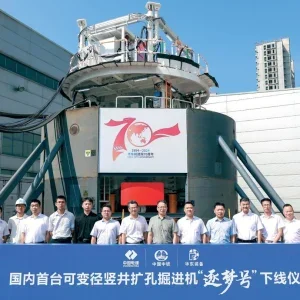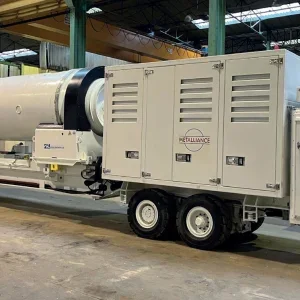Currently, the construction sector is living in a new era where it is expected that lessons learned from the previous mistakes will allow more solid and robust activity. Today, the increasing pressure to reduce costs and increase profit margins remains. For this financial matter it is essential to get the most out of current assets; in other words, it is fundamental to improve productivity. The emergence of industry 4.0 in all sectors, in a manner that has never been seen before, has and will have an immeasurable effect on all activities of the tunnelling sector, and communications are not exempt.
Digital transformation is primarily a business transformation. People, not technology, are the key component of this transformation. It affects all levels of an organisation; therefore, leaders must ensure that this technology-based change can guide productivity gains and significant benefits. The digital transformation of construction will unlock unprecedented amounts of money. It is also relevant to mention that the transformation entails not only technology but equally, issues associated with culture, law, global and virtual teams, employment and new jobs, change and risk management, and many other subjects. This transformation requires a totally different view than those of the recent past.
Digital technologies are causing a high rate of destruction and creation of realities in different fields and industries, including construction. Innovation in communications, remote control, tracking, and data transfer are increasingly being applied to construction operations in the United States.
To innovate is to create new high-value solutions that solve problems that have not yet been resolved or that are poorly resolved. In construction, this translates into higher levels of productivity and operating margins, more production volume, job security, and fewer negative environmental impacts. Innovation generates changes which involve uncertainties, and people’s natural reaction is to fear the unknown. The unknown being the fear of losing power and unemployment. The voices that announce robotisation and artificial intelligence will cause widespread unemployment, are on the rise.
Construction leaders will have to empathise with the people they lead. Communication and continuing education are and will continue to be part of the process of digital transformation in construction.
Continuing education will be ongoing, more frequent and effective in the lives of workers in the construction industry.
Leaky feeder
Until recently, the most advanced tunnel communications solution was leaky feeder. It has long been the communication system of choice. This is not due to the productivity it offers, nor due to the quality or convenience of the system itself. Leaky Feeder had become the standard primarily due to its early availability and that it met the minimum requirements of a communication system.
The reality of the Leaky Feeder system is that it is essentially the low-tech equivalent of running a continuous antenna throughout an underground construction system.
One advantage of a leaky feeder cable is that it can be laid down as the tunnel is being excavated. Splitters can be used to send lengths of cable down different pathways. And since cable is flexible, there’s no problem moving the network around sharp corners and turns. The cable can be feed straight down a hole if need be.
There are a couple of downsides to leaky feeder systems. A primary and ongoing issue with the Leaky Feeder system is the ability of the signals to propagate with maximum efficiency, and the antenna needs to be mounted low, exposing the Leaky Feeder system to damage from mobile equipment. If something severs the cable, communications stop beyond the break.
Another problem is that multiple leaky feeder cables can sometimes cause interference within the system. Leaky feeder radio frequencies tend to be on the high end of the spectrum – these high frequencies don’t penetrate rock very well. Wi-Fi networks are an alternative to leaky feeders. A Wi-Fi network doesn’t require a cable like a leaky feeder system. A fibre optic cable can be a backbone or be a wireless mesh network with no need for cable at all.
Let’s take a closer look at how wireless networks may make tunnelling safer.
Wi-Fi technology
The most useful and up to date digital technology for tunnel projects are Wi-Fi based systems. These systems provide a unified communications and data networks that allow the following:
¦ Two-way voice and texting via Voice over Internet Protocol (VoIP) portable handsets (Phones).
¦ Provides real-time location of people and equipment in the tunnel.
¦ Data communication (for TBMs, roadheaders and other equipment).
¦ Interface to existing radio systems to allow the systems to “talk to each other”.
¦ Remote access to systems
¦ Data acquisition
¦ Video surveillance system in the tunnel.
There are Wi-Fi networks designed to lead tunnelling communications and digital network infrastructure into the future. These network infrastructures have been specifically developed for the tunnelling industry to operate within the harsh environments encountered in all underground operations.
The underground network is the heart of a scalable, high-speed data and communications system. It can cope with time-sensitive, high-bandwidth applications, enabling functionality such as VoIP, video streaming, remote PLC programming, mobile data acquisition, real-time vehicle diagnostics and asset/ personnel tracking. Wi-Fi systems deliver improved capabilities for current and future tunnel requirements through higher reliability and support for open standards.
The Wi-Fi network can converge all data onto a single network. There is no need to run separate optic fibre or copper data lines to get data from critical equipment, such as TBMs. There are systems with up to 1Gb throughput, more than enough capacity to handle all the data requirements of a typical tunnelling operation.
A typical high bandwidth network topology has logical connections between the various IT and OT applications, which can be utilised in an underground project.
The core infrastructure components that comprise the communications platform are:
¦ Wireless network switches
¦ Wireless access points
¦ Composite cable
¦ Antennas
¦ Communications appliance.
Wi-Fi technology applications
Voice Communications
Voice over Internet Protocol (VoIP) phones can connect directly to the tunnel and surface network using wired ethernet or wireless coverage.
Every wireless network switch and wireless access point (WAP) can be used to carry voice calls and messaging. The network solution is installed as a voice ready system and could be integrated to the site IP PBX phone system if it has SIP trunk capability. This would create a seamless network for voice communications when operating on site. Restrictions could be enabled based on each user and call groups established as required. This would provide the following call types:
¦ Call direct to any user
¦ Push to talk to any user
¦ Programmed channels
¦ Emergency broadcast channels
¦ Calls to outside line.
VoIP phones that also have a push to talk (PTT) button can be easily found on the market and are able to communicate to many customisable PTT channels as well as a broadcast channel.
Tracking people and equipment
Tracking systems report the location and track the movement of people and equipment as they travel through the tunnel in real-time.
The tagging and tracking systems use strategically placed Wi-Fi Access Points as readers for RFID Tags. These are normally carried by workers or attached to vehicles and other equipment, so their real-time position is monitored underground and on the surface.
Many of the RFID Tags have a “MAN DOWN” button. If the person holding the tag presses the button, an emergency alarm will be sent to the control room, the location will be known and the spot on the tracking software will be turned RED.
There are many systems that analyse and interpret location data to deliver measurement reporting and comparison against theoretical values, to allow the real-time management of various critical production processes. In tunnelling, if any person or mobile equipment fall outside pre-set parameters for time and location, an alert can be raised to investigate the issue and manage corrective action, before any delay to the process becomes significant.
The most common rules to trigger alarms are:
¦ Breach Site Rule: This alarm triggers if a tag enters or exits a specified restricted zone.
¦ Distribution Site Rule: This alarm triggers when too many are in a defined zone (such as the TBM).
¦ Out of Range Site Rule: This alarm triggers when a person has been out of zone and not come back.
¦ Motion Stop Site Rule: This alarm triggers when a person has been stationary for a long duration.
The functionality could be extended beyond simple location awareness, so in addition to the safety benefits, an investment in a Wi-Fi Tracking System can deliver tangible cost benefits.
Electronic access control
There is a wide variety of electronic access control systems, though, most of them use a rugged computer kiosk. These kiosks send the read information to the server and control room, either wirelessly or wired into the network.
Ventilation on demand
There are different technologies that can be used for fan control solutions. These solutions are normally designed and installed to allow smart control, based on personnel location, and remote control. One possible solution to achieve this is using Miri RTU’s (remote telemetry units), Citect SCADA software, and MST’s MineDash and ImPact communication network infrastructure. The system is designed to meet the requirements of saving power by shutting off fans when there is no one working in the mining heading.
In each ventilation area a switch and an access point should be installed to allow for tag reads in and out of the zone. At each fan starter, a Miri RTU and DC power supply needs to be installed. These RTU’s turn the fans on and off, along with providing status back to the Citect SCADA. These components connect into existing control systems on the fan starter. The Miri RTU also contains ladder logic to jog start the fan.
To smartly control the fans, the following procedure occurs. When a tag enters the zone, the server recognises the tag based on a set of configurable rules and place the information on to a Modbus register. The SCADA software continuously polls looking for any changes to these variables. Once it recognises a change to the rule set, it then sends information to the Master Miri Unit on the surface. From that point it sends the start command “on” to the respective underground Miri RTU. When the server rules see no tags in the mining heading, it goes through the same procedure, turning the fan off (Figure 1).
The ROI of an installation like this is huge. For example, a case study at De Beers Canada’s Snap Lake Mine, had a 25 per cent power savings which meant USD 881,301 per year (Figure 2).
Wi-Fi networks designs
There are serval configurations to install a Wi-Fi platform throughout hereof. The selection of one or the other, depends on the tunnel communication requirements. Fibre based solutions are the most powerful and most reliable. There are many occasions where a wireless mesh network could be very cost effective.
Fibre based Wi-Fi platform
These advanced IP data networks deliver the following operational technology benefits during the initial construction, excavation and tunnelling operation:
¦ Multilayer IP network to accommodate all tunnel operational technology
¦ Rapid deployment networks from the initial surface construction period
¦ A stable and reliable underground electronic tagging solution that is industry proven
¦ Voice & Text communications and Emergency Evacuations Solutions
¦ Video Surveillance solution that can operate on the surface to the tunnel face
¦ Live Data connectivity
A server stack will be installed at each key location and provide the network depending on their specific requirements and project stages. The primary components to be installed in an IT communications rack are the server, IP VHE (Voice Head End) server, RoIP (UHF/VHF – Radio over IP) Radio Bridge, IP surveillance server and network switch (Figure 3).
This operational technology IP ecosystem will provide the platform for all IP technologies to connect and ultimately provide the valuable visual content onto a software (Figure 4).
All the individual site control systems can interconnect with all other sites creating one view for the entire project operation.
This information can also be displayed back at any head office location, training facility or on secure mobile device.
Quality of Service (QoS) is provided on the network VLAN’s and is administrated in accordance with the project IT policies. This allows management of all the applications and prioritising for the data, voice, video and other traffic on the network via the one gigabit copper and fibre composite cable.
Wireless mesh networks
There are tunnel projects where full coverage along the tunnel is not needed, and people mainly work on the TBM (or in any particular area) and on the surface. Under these circumstances, communication is mostly required at both job locations, and in the event a temporary job needs to be done somewhere in the middle of the tunnel, wireless repeater nodes (WRN) could be used to provide temporary Wi-Fi coverage.
WRNs simplify the connectivity in the most dynamic areas underground, providing wireless connection to the working faces. A core requirement to leverage IoT is to have a reliable Wi-Fi connection. There are many WRN that meet this requirement and extend the Wi-Fi platform from the fixed infrastructure to the active working faces. These repeaters also include an 802.11n (IEEE) interface to allow easy access to the many Wi-Fi devices.
This solution allows different tunnel configurations, being the system so flexible, it is down to the project to choose the configuration that best meets their project requirements. Figures 5 and 6 show a few scenarios studied, using an 802.11 n 2.4GHz WRNs:
Figure 5 shows the best configuration to locate up to seven wireless repeaters nodes (WRN) in the tunnel. Under this design, up to 10 VoIP phones could be used at the same time to communicate from point A to point B with no problem at all. In other words, being all 10 VoIP phones making calls at the same time.
Figure 6 shows the worst configuration to have seven WRN in a tunnel. Under this design, only four VoIP phones could be used at the same time to communicate from point A to point B.
This operational technology IP ecosystem will provide the platform for all IP technologies to connect. All the individual site control systems can interconnect with other sites creating one view for the entire project operations. This information can also be displayed back at any customer head office locations, training facility or on secure mobile devices.
Combination of wireless mesh networks with a fibre-based Wi-Fi platform
There are many circumstances, where only voice communication is needed. Yet, if there is a fibre optic cable in the tunnel, a very cost-effective solution is combining repeaters nodes with switches in the tunnel.
By using WAPs to create a mesh from switch to switch, there is no need for breaking the fibre frequently throughout the tunnel.
A server stack should be installed at a key location and provide the network systems for the site depending on their specific requirements and project stages. The primary components to be installed in an IT communications rack are the IP Voice Head End (VHE) server, IP surveillance server and network switch. These systems will provide important network services such as Wi-Fi for both voice and network access, establish the tag and tracking solution for the underground works and the like.
The design of the installation for the tunnel is shown in Figure 7.
This solution consists of installing a switch at the entrance of the tunnel, connected to the TBM’s fibre optic (or the tunnel fibre optic), and a switch installed at the TBM (or at the other end of the tunnel).
Approximately each 2,000ft (609m), a WAP will be connected to the LV 240V network, extending the Wi-Fi signal throughout the tunnel. If power supply is not available in the tunnel, WRN can be used instead.
WAPs don’t need to be physically connected with one another, that’s why no cable is needed. It is a wireless solution that will provide Wi-Fi to the entire tunnel.
Conclusions
It has been a long-held assumption that because digital wireless systems are rooted in modern technology, those systems will be more expensive and there-by harder to justify than the leaky feeder systems. The reality is that because the Wi-Fi systems do use modern, proven technologies and materials, it is in fact price preferred when tracking and other expandable options are considered in the evaluation.
Wi-Fi systems is a modern alternative, offering advantages that are not and cannot be available with the leaky feeder and in a very early stage for underground LTE. These systems are generally 16 per cent less costly than leaky feeder when tracking and voice are included in the system.
Traditional surface enterprise networks have a star topology which requires power at every network node. This is not a cost-effective solution underground. The challenge of limited power availability underground is overcome by using a composite cable, which acts as a power distribution system, as well as carrying the optic fibre data cores.
For a large-scale operation, the level of Wi-Fi coverage needs to be defined. Depending on the budget for its implementation there might be different options like:
¦ Fibre based Wi-Fi platform
¦ Wireless mesh networks
¦ Combination of wireless mesh networks with a fibre-based Wi-Fi platform. If there is a fibre optic cable in the tunnel, there is no more cost-effective communication system than Wi-Fi.
If only voice communication is required, mesh networks are positioned as the best solution for tunnels’ length smaller than two miles.






